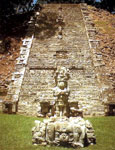|
MAJOR ARCHAEOLOGICAL SITES: PreClassic to PostClassic
COPÁN (circa A.D. 400-800)
Copán is located in the nation of Honduras but it is frequently more convenient to visit the ruins in conjunction with a visit to highland Guatemala as well. The ruins are located about 150 miles from Guatemala City and can be reached in a few hours. Despite the fact that some occupations in the Copán Valley date to the early PreClassic era when local chiefs may have monopolized a jade source prized by the Olmec of the Mexican Gulf Coast, it wasn’t until after A.D. 400 that major construction of the main ceremonial complex was actually begun. Copán’s central ceremonial precinct extended along a natural ridge and was divided into three main areas, the Great Plaza, the Middle Plaza, and the Acropolis.
 |
Archaeologists believe the Great Plaza was an early eighth-century expansion to the Acropolis. Most of the monuments found in the Great Plaza are portraits of a single ruler known as Waxaklahun Ubah K’awil (Lord Eighteen Rabbit) who inherited the throne in A.D. 695. This remarkable ruler’s stelae are carved in such deep relief that they almost convey a sense of statuary. Despite this magnificent tribute, Ubah K’awil was ultimately executed by the lord of nearby Quiriguá who made Copán a tributary until it regained its hegemony during the last half of the eighth century. Click on Image for more detail. |
 |
The Hieroglyphic Stairway was constructed in the Middle Plaza as a declaration of Copán’s resurgence under Lord Smoke Shell, whose monument, Stela M, appears at the base of the pyramid. Click on Image for more detail. |
 |
Altar Q was set by Copán’s sixteenth ruler, Yax Pasah, before Temple 16 at the Acropolis. It depicts Yax Pasah receiving a baton of office from the deceased founder of his dynasty, Lord Yax K’uk Mo’. Lineage ancestors who ruled between the founder and Yax Pasah are also portrayed. Archaeological dating of the early substrata appear to confirm 5th century dates for the founding of Copán that is suggested by the texts on such monuments as Altar Q. Click on Image for more detail. |
Previous Page | Sites Index | Next Page
Table of Contents
Return to top of page |




